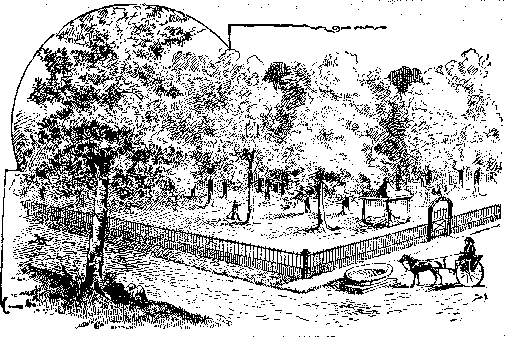
The Battle Ground, from the Northeast
| The Battle of Tippecanoe |
The field upon which the battle of Tippecanoe was fought is located in Tippecanoe township, of Tippecanoe county, seven miles north of the city of Lafayette, Ind. The land upon which the battle occurred is situated in sections twenty-three and twenty-six, township twenty-four, range four west, and is embraced in a tract of 200 acres entered by John Tipton, November 13, 1829. Mr. Tipton was native of Tennessee, and enlisted in Governor Harrison's army as an ensign at Corydon, Ind. He was in the struggle of Tippecanoe, and after that battle received promotion for his valiant conduct.
General Harrison buried his dead and burned logs over their graves to conceal the spot of interment. The Indians, however, found the place and disinterred the fallen brave. General Hopkins visited the battlefield the following year, gathered the scattered remains and replaced them in their graves.
In the spring of 1830, the year following the Tipton purchase, a large meeting of survivors of the battle and other distinguished persons, among whom was General Harrison, was held upon the battlefield. The bones of the dead were collected and placed in one grave on the tract deeded by Tipton to the State on the 25th anniversary of the battle of Tippecanoe, November 7, 1836. This tract embraced sixteen and fifty-five hundredths acres

(more or less). Shortly afterward it was inclosed by a rail fence. This spot has been a favorite place for holding great political gatherings. The whigs rallied there for three days during the "Tippecanoe and Tyler" campaign of 1840, and again in 1844, when the Henry Clay was their standard bearer. In 1856 it was the scene of rival republican and democratic rallies. The latter was addressed by John C. Breckinridge, of Kentucky, then a candidate of his party for the vice-presidency. The campaign of 1888 revived the memories of Tippecanoe, and on October 17th and 18th a large republican rally was again held at the Battle Ground.
The Indiana Constitutional Convention of 1851 made provisions for the preservation of the battlefield. Section 10, of Article XV, of the Constitution, reads as follows:
"Tippecanoe Battle Ground. It shall be the duty of the General Assembly to provide for the permanent inclosure and preservation of the Tippecanoe Battle Ground."
This act of the constitutional convention was a great recognition of the importance of that historic field. In compliance therewith, it was soon afterward inclosed with a substantial board fence.
By an act of the General Assembly , approved December 18, 1872, the sum of $24,100 was appropriated to erect an iron fence around this famous field. This duty devolved upon the governor, secretary, auditor and treasurer of State, who accomplished the work in elegant style, using only about $18,000 of the amount placed at their command. The remaining $6,000 was returned to the State treasury.
An act of March 7, 1887, provided $3,500 for repainting the fence and necessary repairs. The act also appropriated $300 annually thereafter, which sum is used as salary of custodian of the grounds and for needed repairs. The commissioners of Tippecanoe county were made the supervisors of this work, and have expended about $2,500 of the amount appropriated. It is now proposed to erect a building upon the grounds, to be occupied by the custodian.
A village was founded immediately north of the battlefield, and bore the name of Harrisonville until the construction of the Louisville, New Albany & Chicago Railroad in 1853, when that place, with additions, was incorporated as Battle Ground City, which is now the home of about 500 souls. The place is noted in religious circles as the camp-meeting ground for the Northwest Indiana Conference of the Methodist Episcopal Church. Many religious meetings have been held there almost as strong, numerically, as the great political assemblies for which the site has been noted in the past.